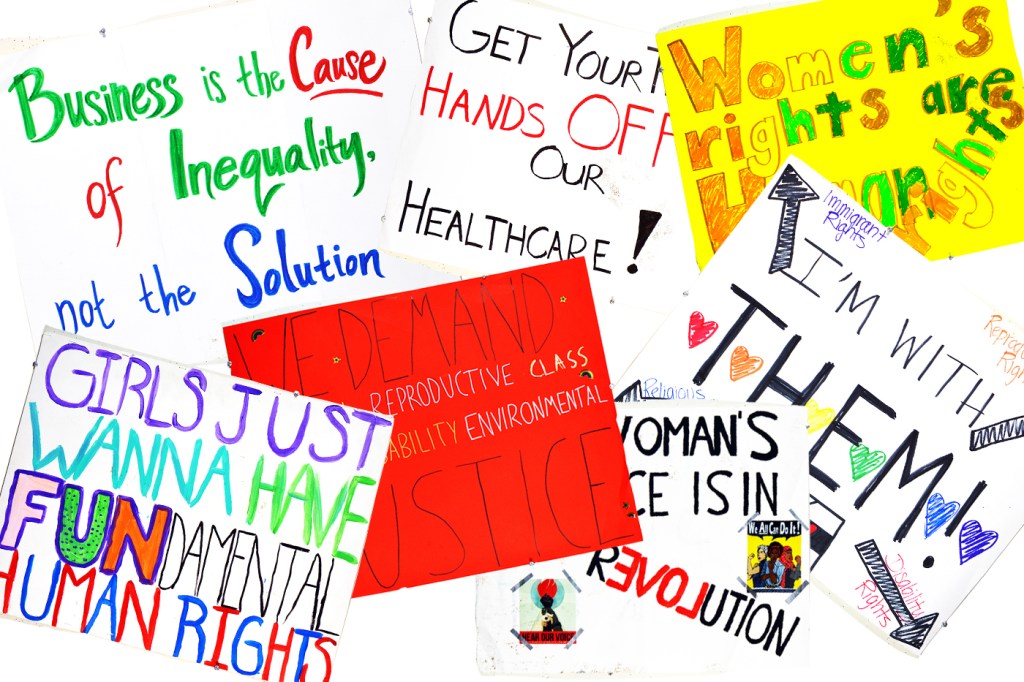Digital archive preserves groundbreaking moment in civic activism

In solidarity with millions of others around the world, a crowd of some 175,000 people converged on Boston Common the day after President Donald Trump’s inauguration to promote human rights and gender equality. The throng carried a host of signs—some erudite, some simple, some crude—each one reflective of a passion, cause, or dream.
It’s only by a happy accident that many of those signs from that first Women’s March still exist. They’re now available to the public not in poster form but as a searchable digital archive, thanks primarily to the efforts of several Northeastern professors.
The group plans to release a series of visualizations and a public application programming interface so that others can work with the images and the metadata they created.
It began when three College of Arts, Media and Design professors and friends who had attended the march returned to the Common after lunch to notice that many protesters had left their signs in an improvised memorial around a fence.
“It was a snapshot of this place and time,” said assistant professor Dietmar Offenhuber, who holds joint appointments in the Department of Art + Design and the School of Public Policy and Urban Affairs, one that he and his colleagues, experts in information design and visual communication, couldn’t ignore.
“It was fascinating to notice the civic etiquette that prompted people to weave the signs into the fence and lay them so carefully against each other,” said design professor Nathan Felde. “The incredible range of individual expression [in these signs] exposes a richness of ideas that can move us away from polarity in politics. Our world of binary choices—‘for and against’, ‘yes and no’, and ‘winners and losers’—seems to be clearly yearning for a common ground where ‘maybe’ yields consideration of more creative options.”
He imagined that the improvised tribute to the march started when one or two people on their way home left their signs instead of taking them onto the subway. Soon, the entire fence was covered, “making a public collective artifact.”
“It formed a perfectly spontaneous installation,” he said.
Along with Alessandra Renzi, who is now a professor at Concordia University, Felde, Offenhuber, their friends, and dozens of volunteers fashioned a rescue. Working against the clock—rain was coming the next day, and sanitation workers were on their way—the team rented a van and worked until almost midnight, stuffing as many posters as possible into the vehicle.
They estimated they saved about 2,000 posters. Imagine their surprise when they laid out each one to be digitized and counted more than 6,000.
The value comes from the scale and completeness of the collection. As Felde explained, “[it’s] a pretty big sample size. It’s a solid representative sample of the expressions, ideas, and sentiments of the individuals in the march.”
But the sheer size of the collection was also a challenge. The professors turned to the staff at Snell Library, which has an extensive collection of digital archives, to consult on the daunting process of categorizing the signs with the appropriate themes and categories. After procuring warehouse space, the team collaborated with volunteers they’d met at the march and other Northeastern colleagues and family to lay out all the posters and spent several days digitizing the collection.
It’s no coincidence that the unveiling of the archive coincided with the second Women’s March, almost one year after the original groundbreaking event. According to Felde, scholarship around the collection is continuing at Northeastern and beyond. Several institutions have made requests to host installations, including a new museum dedicated solely to the art of the poster.
“The collection captures the totality and discourse, something you can’t have with just one sign,” Offenhuber said.





